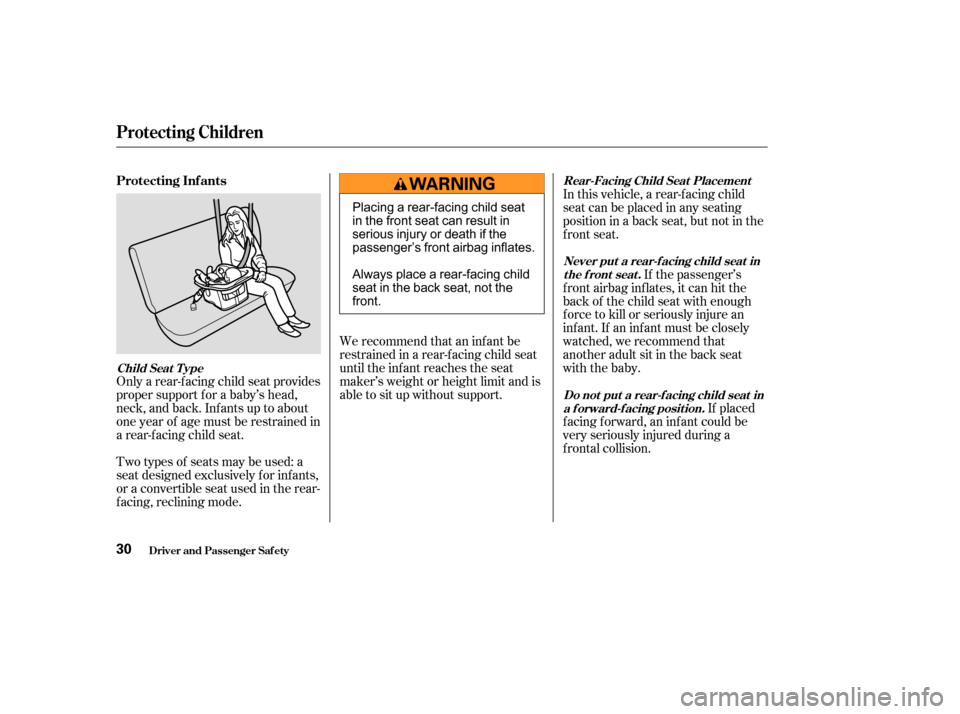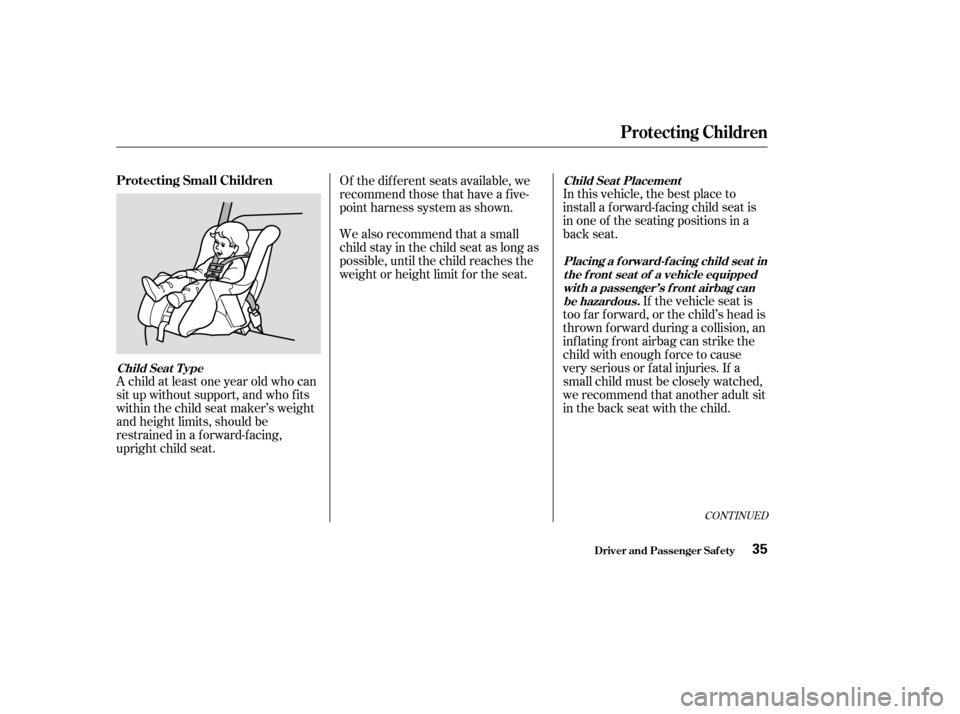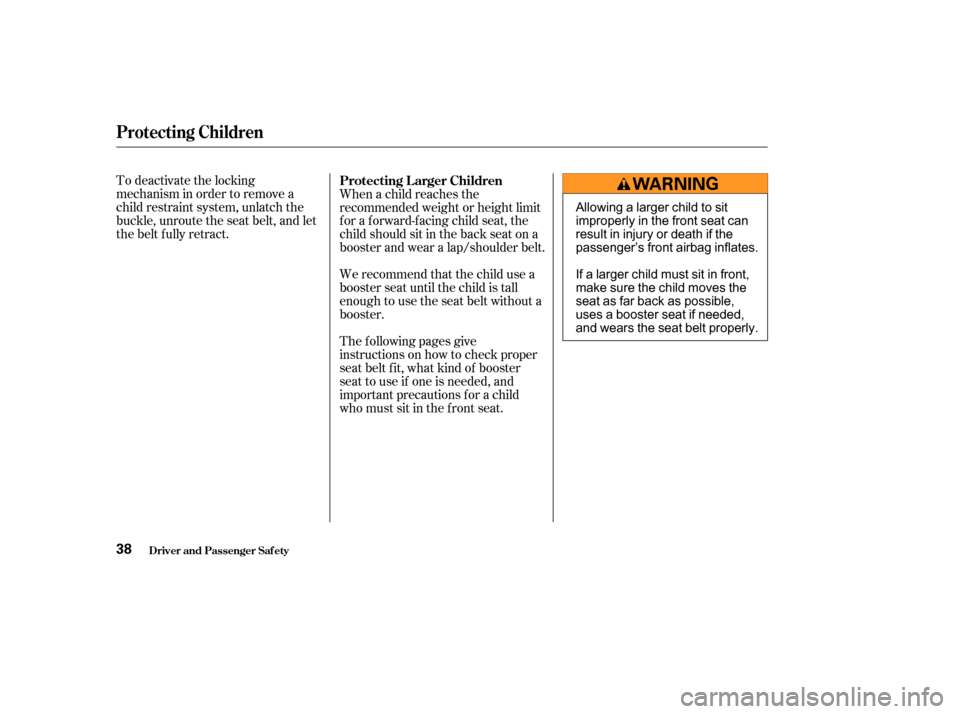Page 20 of 392
If the seat belt touches or crosses
your neck, or if it crosses your arm
instead of your shoulder, you need to
adjust the seat belt anchor height.
If necessary, pull up on the belt again
to remove any slack from the
shoulder part, then check that the
belt rests across the center of your
chest and over your shoulder. This
spreads the f orces of a crash over
the strongest bones in your upper
body. To adjust the height of a f ront seat
belt anchor, squeeze the two release
buttons and slide the anchor up or
down as needed (it has f our
positions).
Driver and Passenger Saf ety
Protecting Adults
16
RELEASE
BUTTON
Improperly positioning the seat
belts can cause serious injury
or death in a crash.
Make sure all seat belts are
properly positioned before
driving.
Page 34 of 392

Only a rear-f acing child seat provides
proper support f or a baby’s head,
neck, and back. Inf ants up to about
one year of age must be restrained in
a rear-f acing child seat.We recommend that an inf ant be
restrained in a rear-f acing child seat
until the inf ant reaches the seat
maker’s weight or height limit and is
able to sit up without support.
Two types of seats may be used: a
seat designed exclusively f or inf ants,
or a convertible seat used in the rear-
f acing, reclining mode. In this vehicle, a rear-f acing child
seatcanbeplacedinanyseating
positioninabackseat,butnotinthe
front seat.
If the passenger’s
f ront airbag inf lates, it can hit the
back of the child seat with enough
f orce to kill or seriously injure an
inf ant. If an inf ant must be closely
watched, we recommend that
another adult sit in the back seat
with the baby.
If placed
f acing f orward, an inf ant could be
very seriously injured during a
f rontal collision.
Protecting Inf ants
Child Seat T ype
Rear-Facing Child Seat Placement
Never put a rear-f acing child seat inthe front seat.
Do not put a rear-f acing child seat ina f orward-f acing position.
Protecting Children
Driver and Passenger Saf ety30
Placing a rear-facing child seat
in the front seat can result in
serious injury or death if the
passenger’s front airbag inflates.
Always place a rear-facing child
seat in the back seat, not the
front.
Page 39 of 392

In this vehicle, the best place to
install a f orward-f acing child seat is
in one of the seating positions in a
back seat.
We also recommend that a small
child stay in the child seat as long as
possible, until the child reaches the
weight or height limit f or the seat. Of the different seats available, we
recommend those that have a f ive-
point harness system as shown.
If the vehicle seat is
too far forward, or the child’s head is
thrown f orward during a collision, an
inflating front airbag can strike the
child with enough f orce to cause
very serious or f atal injuries. If a
small child must be closely watched,
we recommend that another adult sit
in the back seat with the child.
A child at least one year old who can
sit up without support, and who f its
within the child seat maker’s weight
and height limits, should be
restrained in a f orward-f acing,
upright child seat.
CONT INUED
Protecting Small Children
Child Seat T ype Child Seat Placement
Placing a f orward-f acing child seat int he f ront seat of a vehicle equippedwit h a passenger’s f ront airbag canbe hazardous.
Protecting Children
Driver and Passenger Saf ety35
Page 42 of 392

To deactivate the locking
mechanism in order to remove a
child restraint system, unlatch the
buckle, unroute the seat belt, and let
the belt fully retract.When a child reaches the
recommended weight or height limit
for a forward-facing child seat, the
child should sit in the back seat on a
booster and wear a lap/shoulder belt.
We recommend that the child use a
booster seat until the child is tall
enough to use the seat belt without a
booster.
The f ollowing pages give
instructions on how to check proper
seat belt f it, what kind of booster
seat to use if one is needed, and
important precautions f or a child
who must sit in the f ront seat. Protecting L arger Children
Protecting Children
Driver and Passenger Saf ety38
Allowing a larger child to sit
improperly in the front seat can
result in injury or death if the
passenger’s front airbag inflates.
If a larger child must sit in front,
make sure the child moves the
seat as far back as possible,
uses a booster seat if needed,
and wears the seat belt properly.
Page 96 of 392
To adjust the seat-back angle of the
third seat, pull on the handle on the
back of the seat-back, move the seat-
back to the desired position, and
release the handle. Let the seat-back
latch in the new position.
To change the seat-back angle of the
seats in the second row, pull up on
thehandleontheoutsideof theseat-
back.
The height of your driver’s seat is
adjustable. Turn the front dial on the
outside of the seat cushion to raise
the front of the seat bottom, and turn
the rear dial to raise the rear.On LX model
Seats
Inst rument s and Cont rols
Second and T hird Row Seat
Adjustments
Driver’s Seat Manual Height
Adjustment
92
SECOND
SEAT
THIRD
SEAT
HANDLE
Page 97 of 392
See page f or important saf etyinf ormation and a warning about how toproperly position the head restraints. 14
To remove a head restraint f or
cleaning or repair, pull it up as f ar as
it will go. Push the release button
and pull the restraint out of the seat-
back.
The head restraints help protect you
and your passengers f rom whiplash
and other injuries. They are most
ef f ective when you adjust them so
the back of the occupant’s head rests
against the center of the restraint. A
taller person should adjust the
restraint as high as possible. Your vehicle is equipped with head
restraints in all seating positions.
The head restraints in the second
and third row seats adjust f or height.
You need both hands to adjust the
restraint. To raise it, pull upward. To
lower the restraint, push the release
button sideways and push the
restraint down.
Head Restraints
Seats
Inst rument s and Cont rols93
RELEASE BUTTON
Page 261 of 392

The added weight, length, and
height of a trailer will af f ect your
vehicle’s handling and perf ormance,
so driving with a trailer requires
some special driving skills and
techniques.
Foryoursafetyandthesafetyof
others,taketimetopracticedriving
maneuvers bef ore heading f or the
open road, and f ollow the guidelines
discussed below.
Avoid towing a trailer during your
vehicle’s f irst 500 miles (800
kilometers) (see page ).Drive slower than normal in all
driving situations. Obey all local
speed limits f or vehicles with trailers.
To keep the transmission f rom
f requently upshif ting and
downshif ting, drive in D. When
driving with a f ix-sided (e.g, camper,
utility) trailer, do not exceed 55 mph
(88 km/h). At higher speeds, the
trailer may sway or affect vehicle
handling.
Maketurnsmoreslowlyandwider
than normal. The trailer tracks a
smaller arc than your vehicle, and it
canhitorrunoversomethingthe
vehicle misses. Allow more time and
distance f or braking. When you need
to slow down, slowly lif t your f oot of f
the throttle and gradually apply the
brakes. Do not brake or turn
suddenly as this could cause the
trailer to jackknif e or turn over.
216
CONT INUED
Driving Saf ely With a T railer
Break-In Period T owing Speed
Making T urns and Braking
Towing a Trailer
Driving257
Page 366 of 392

�Î�Î
�Î
�Î
�µ�µ �Î �Î
�Î
�Î
Specif ications
T echnical Inf ormation362
Capacities
Dimensions
Weights
Air Conditioning Fuel tank
Engine
coolant
Engine oil
Automatic
transmission
fluid
Rear
differential
fluid
Windshield
washer
reservoir
1.74 US gal (6.6
, 1.45 Imp gal)
2.25 US gal (8.5, 1.87 Imp gal)
5.1 US qt (4.8
, 4.2 Imp qt)
4.5 US qt (4.3
, 3.8 Imp qt)
5.8 US qt (5.5
, 4.8 Imp qt)
3.2 US qt (3.0, 2.6 Imp qt)
8.2 US qt (7.8, 6.9 Imp qt)
Including the coolant in the reserve tank and that remaining in the
engine.
Reserve tank capacity:
0.16 US gal (0.6
, 0.13 Imp gal)
Excluding the oil remaining in the engine. 19.3 US gal (73
, 16.1 Imp gal)
2.79 US qt (2.64
,2.32Impqt)
188.0 in (4,775 mm)
76.3 in (1,938 mm)
70.6 in (1,793 mm)
4.8 US qt (4.5
, 4.0 Imp qt)
66.3 in (1,685 mm)
66.5 in (1,690 mm)
Length
Width
Height
Wheelbase
Track
Gross vehicle weight rating
Gross combined weight
rating (GCWR)
See the tire information label atta-
ched to the driver’s doorjamb.
9,700 lbs (4,400 kg)
Refrigerant type
Charge quantity
Lubricant type HFC-134a (R-134a)
24.7 26.5 oz (700 750 g) ND-OIL8
106.3 in (2,700 mm)
Approx.
Front
Rear
1:
2:
Equipped with transmission fluid cooler and power steering fluid
cooler. Change
Total
Change
Including
filter
Without
filter
Total
Change
Total
Change
The GCWR must be reduced 2 percent for every 1,000 feet (305
meters) of elevation.
1:
2:
2 1
2
1